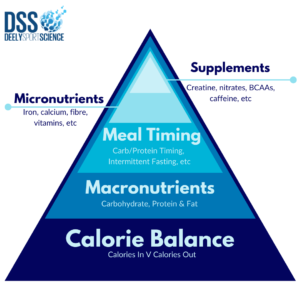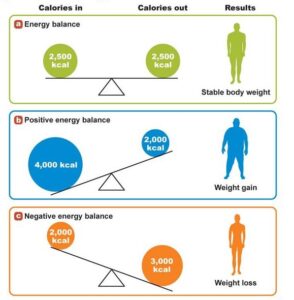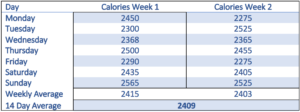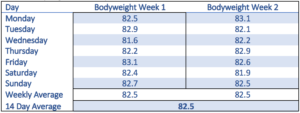
06 Aug Nutrition 101: Calorie Balance – By John Murphy MSc, PhD researcher
By John Murphy (MSc, PhD researcher)

Figure 1 – Nutrition Pyramid
Part 1 – Calorie Balance
This series will dive into the various components of nutrition, how they drive changes in the body and how this impacts both health and performance. The most popular goals people have in terms of nutrition are to either lose fat, gain muscle and/or fuel performance. While all three are certainly possible at the same time, it is much easier to break these into categories at various stages of the year and align them to our training/performance goals at the same time. This is similar to how we periodise our physical, technical and tactical training for the season. While addressing the three most popular goals mentioned above, it is important to understand the main principles that drive changes in the body so we can make individual adjustments as we go along. Many people focus their attention on nutrient timing and supplements yet disregard all of the nutrition practices that should be in place before these have an impact. The above pyramid places calorie balance at the base as it is the most important component. This article discusses calorie balance with particular attention given to:
- What Is A Calorie (Energy)
- How Many Calories?
- Lack Of Calories
- Excess Calories
- How To Manipulate Energy Balance
Over the next few weeks we will address each level of the pyramid and give practical tips on how we can implement some simple steps that will have a positive impact on performance.
What are calories and what do we mean by “balancing” them?
A calorie is a unit of measurement for energy. Just like centimetres for distance, kgs for weight, m/s for speed, and so forth, calories are used to measure the potential energy in a macronutrient, food or meal. When we talk about “balancing calories” we mean that the amount of calories we eat in a day should be the same as the amount we burn in a day. That’s the overall governing principle of weight loss, weight gain and weight maintenance. Every diet, meal and nutrient manipulation used by nutritionists, dietitians and personal trainers is designed to achieve either a positive or negative calorie balance based on the athlete’s needs.

Figure 2 – Energy Balance
In very simple terms:
- If we eat the same amount as we burn – our weight stays the same
- If we eat more than we burn – our weight goes up
- If we eat less than we burn – our weight goes down
There will be many fluctuations on our day-to-day weight due to fluids, sodium balance, stress and many of the other processes that happen internally that are largely unrelated to calorie balance.
Bearing in mind the above points, answer these questions:
- Can we lose weight while eating only food from McDonald’s?
- Can we gain weight when eating only grilled chicken, brown rice and steamed broccoli?
The answer to both is yes but highly unlikely. McDonald’s food is very high in calories and small in volume or size (calorie dense). A typical meal can easily contain ~1000 calories or more. Three of these meals in a day would leave many people above their calorie requirements while still feeling low on energy and often rather hungry. This leads to extra eating so a further increase in calories, and therefore, weight gain. The chicken, rice and broccoli, in comparison, is quite low in calories in with a large volume (or size). This leaves us feeling much fuller although we’ve eaten considerably less calories. The chicken meal is also less appetising (and bland) so we’re far less likely to over consume.
While it’s easy to keep saying we should balance our calories, it’s just a generic piece of unactionable advice unless we have some idea on how to monitor both the input and output. Calculating our exact input and output is very difficult to do and requires a lot of expensive equipment. There are, however, many ways to estimate, with a reasonable level of accuracy, both our input and output without too much effort on our part. It’s also worth noting that calculating our calorie needs and tracking intake every day is certainly not necessary but trying it at least once for a few weeks does provide a greater understanding of what we are eating and the impact it has on our body. The two methods we’re suggesting are to (1) track intake and balance it against bodyweight and (2) us a calorie calculator.
Track Intake & Bodyweight
There are many calorie trackers available with MyFitnessPal being the most popular. Check out YouTube for tutorials on how to most accurately use MyFitnessPal (or another calorie tracker of your choice). Track your calorie intake and bodyweight every day for about 2 weeks. Find an average of both. If bodyweight remains relatively stable then your average intake of calories is what’s required (see table 1 & 2). If your weight goes up over the 14 days then your daily calories is most likely 150-300 below the average of the past 14 days. If your weight goes down slightly then your daily calories is most likely 150-300 calories above the average.
Table 1 – Calorie Intake Over 14 Day Period

Table 2 – Bodyweight Over 14 Day Period

Calorie Calculator
There are a number of equations that can be used to calculate our daily calorie needs. After trialling a few with various athletes and clients I’ve compiled the most accurate male and female calculators into a spreadsheet which can be accessed Here For Males and Here For Females. Just download a copy of the spreadsheet to your own drive and fill in your height, weight and age. This will give an estimate of how many calories you need for different days based on activity levels. It’s still worth monitoring weight over time even if following these guidelines as our own perceptions of how active (or inactive) we are can be way off.
Not Consuming Enough Calories
As stated above, calories are a measurement of energy. If we don’t eat enough then we automatically suffer from all the negative implications of insufficient energy. Some endurance athletes will know what it feels like to realise they haven’t eaten enough around mile 21 of a marathon or with an hour to go on a long cycle as they reach the bottom of a long climb. This lack of energy in the acute sense automatically leads to an immediate drop in physical performance, reduced concentration (as our brain is lacking energy) and an overall drop in confidence. Not consuming enough calories in the long term lead to reduced training output, greater difficulties in improving fitness levels (as we don’t have enough fuel to drive or recover from training) and increased risk of injury and illness. Reducing calorie intake at certain stages of the year may be necessary if we need to reduce bodyweight (most likely fat) but this should be well planned to coincide with specific stages of the macrocycle.
Consuming Too Many Calories
While there are benefits to slightly overconsuming calories in the brief lead-in to an important game (24 hour period), in the longer term, consistently overconsuming will lead to weight-gain (most of which will be fat). Excess weight will generally have a negative impact on performance, particularly sports with an endurance component. If we imagine ourselves doing any popular aerobic fitness test (1km time trial, Yo-Yo, etc) as we normally are then with a schoolbag or weighted vest on, we’re going to see a negative drop in performance. Not only will we see a negative drop in performance but the relative effort required to perform will also increase (although both should be maximal effort) and we will most likely take longer to recover. Carrying extra bodyfat will also have negative effects on our general health as it places excess pressure on our internal organs and often negatively impacts self-esteem.
Manipulating Energy Balance
Counting calories and monitoring bodyweight for a period of time will teach you quite a bit about your diet and it’s interaction with the body but is certainly not necessary for everyone. Perceived energy levels, how our clothes are fitting, general mood, and training performance are other useful subjective metrics that can be used. We can manipulate calorie intake by adjusting portion sizes, meal frequency and the density of foods we eat.
Tips for lowering calorie intake:
- Avoid liquid calories (smoothies, juices, alcohol)
- Add a large portion of veg with each meal
- Eat a side salad before the rest of lunch and/or dinner
- Limit yourself to 1 cupped hand of carbohydrate with main meals
Tips for increasing calorie intake:
- Drink a glass of milk with each meal
- Add a spoon of peanut butter to your porridge
- Add an extra half portion of carbohydrate to your main meals
- Plan high calorie snacks and bring them with you each day for 10am and 3pm (approx)
TL;DR
- Calorie balance is the governing principle for weight and energy balance in the body
- Calories are a unit of energy
- Too many calories leads to weight (mostly fat) gain
- Too few calories leads to insufficient energy and weight loss
- Changes in calorie balance should be based on long-term training and performance goals (periodised)
The next instalment will look at the macronutrients that provide calories to the body and how they impact on performance.
If you want further information on anything said here then feel free to contact me (John) at [email protected].
You can find my profile on The Twitter Machine or The Gram for more recipes and nutrition info.



No Comments